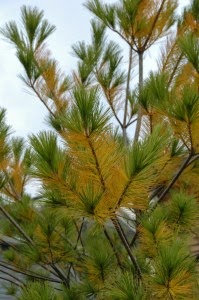 |
| A mini-gourd with fresh flower arrangement |
Enjoying one of the last mild autumn evenings, Penn State Master Gardeners, Franklin County and guests gathered for their annual recognition dinner and program at Chestnut Landing, Menno Haven.
As usual the Special Events Committee provided beautiful centerpieces for the tables and each attendee was able to take home miniature flower arrangements presented in small hollowed gourds.
 |
| George and Sue Weigel (L,Miller) |
The evening included a delicious dinner and a program by George Weigel, Central PA Garden Writer, Horticulturist and (per his Website) Certified Gardening Nut. George brought copies of his new book, "Pennsylvania Getting Started Garden Guide," for sale and signing. And also a box full of hyacinth bean seed pods - some were taken to MG homes for next year and the remainder went home with Juanita Kauffman for the greenhouse and plant sale.
 |
| John McGinley, MC (L.Miller) |
In introducing our speaker, John related the story of how he, then a features editor and colleague of George at the Patriot-News and a Certified Gardening Wacko himself, one day said to George, “You like to garden, right? How’d you like to write a weekly gardening column?”
 |
| George talks about winter problems (L. Miller) |
 |
| Donna Scherer (L.Miller) |
Nina Redding, District Extension Director, made brief remarks on the accomplishments of the Master Gardener. Donna then handed out both recognition certificates and the coveted MG hour badges with volunteer hours listed (500, 1000, etc.).
The 2014 Master Gardener class was recognized.
 |
| (L-R) Verna Rife, Darlene Sord, Donna Scherer, Ruth Young, Cathy Campbell, Jessica Kauffman, Pat Glasgow, Ron Schlecht (L.Miller) Not present: Jane Birt, Krista Cowan, Trey Gelbach, Walter Wray |
Master Gardeners who achieved the 100 hour volunteer mark did not get MG hour badges but were recognized with certificates.
Jane Birt - David Brashier - Cathy Campbell - Patricia Glasgow - Colleen Johnson - Jessica Kauffman - Paul Luka - John McGinley - Diane Morgan - Billy Morningstar - Tom Newcomer - Cindy Scanzello - Ronald Schlecht - Judith Scriptunas - Ruth Young
Volunteers with 500 hours
 |
| (L-R) Barbara Boyer, Penny Buckus, Jerry Lewis, Carol Kagan, Juanita Kauffman, Diane Keeney, Georgia Townsend (L. Miller) Not present: Cindy Fair |
Diane Fusting and Cindy Stead achieved the 1000 hour status.
Both Linda Horst and Denise Lucas hit to 1500 hour mark.
 |
| Denise Lucas and Donna Scherer (L.Miller) Not present: Linda Horst |
 |
| Barb Petrucci and Donna Scherer (L. Miller) |
And Nancy Miller with this year's top number of 2500 hours.
 |
| Nancy Miller and Donna Scherer (L. Miller) |




































